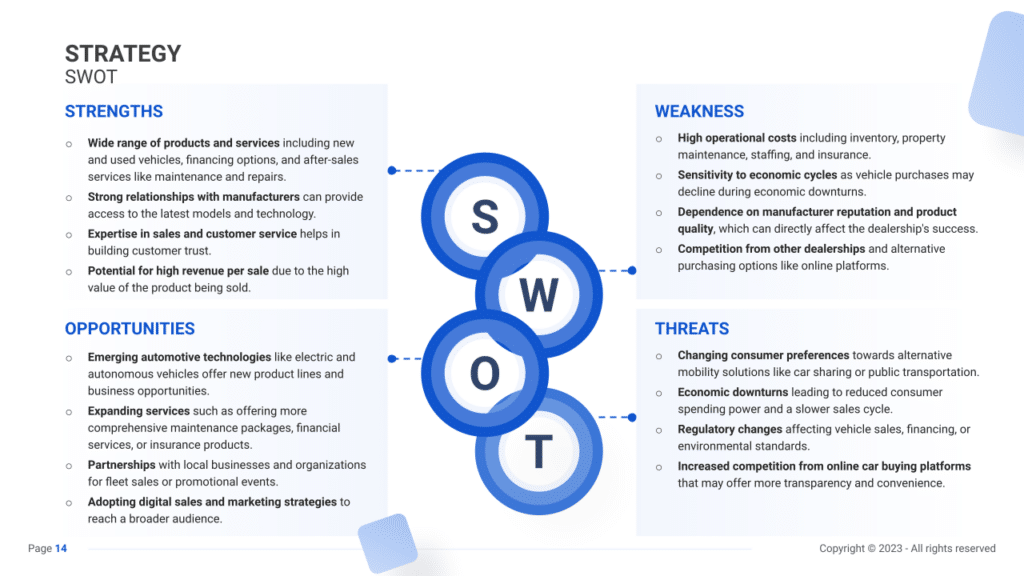SWOT Analysis for a Car Dealership (Example)

A SWOT analysis is crucial for developing a business plan for a car dealership. This analysis, which stands for Strengths, Weaknesses, Opportunities, and Threats, helps understand internal and external factors that can impact your business. Strengths and weaknesses are internal to the business, while opportunities and threats are external.
In this article, we will explore various examples of strengths, weaknesses, opportunities, and threats, aiding car dealership owners in incorporating these insights into their business strategies.

Strengths
Highlight strengths that set the dealership apart from competitors and contribute to its success:
- Strong Brand Partnerships: Collaborating with reputable automobile manufacturers and having exclusive deals can attract customers seeking specific brands or models.
- Example: Showcase partnerships with renowned brands prominently in marketing campaigns and showroom displays to enhance credibility.
- Experienced Sales Team: A knowledgeable and skilled sales team can significantly impact sales and customer satisfaction.
- Example: Invest in continuous training programs to keep the sales team updated with the latest industry knowledge and sales techniques.
- Service and Maintenance Facilities: Offering exceptional post-sales service and maintenance can enhance customer loyalty.
- Example: Highlight the dealership’s state-of-the-art service facilities and efficient maintenance services to attract customers concerned about after-sales support.
- Diverse Vehicle Inventory: Having a wide range of vehicles in stock, catering to various preferences and budgets, can attract a broader customer base.
- Example: Regularly update marketing materials and online listings to showcase the diversity of available vehicles.
Weaknesses
Address weaknesses for the sustainable growth and improvement of the car dealership:
- Limited Online Presence: Inadequate utilization of online platforms for marketing and sales can result in missed opportunities.
- Example: Invest in a comprehensive online presence, including a user-friendly website and active social media engagement, to reach a wider audience.
- High Overheads: High operational costs, including showroom maintenance and staffing, can impact profitability.
- Example: Implement cost-cutting measures and explore efficient staffing strategies without compromising customer service.
- Inventory Turnover Time: Slow turnover of inventory can tie up capital and limit the introduction of newer models.
- Example: Develop marketing strategies and clearance sales to reduce inventory backlogs and facilitate quicker turnover.
- Dependency on Manufacturer Incentives: Overreliance on manufacturer incentives or promotions can affect profitability during changes in manufacturer policies.
- Example: Diversify revenue streams and develop marketing strategies that are less reliant on manufacturer incentives.
Opportunities
Identify and leverage external opportunities to expand the dealership’s market presence and offerings.
- Rise in Electric Vehicle Demand: The increasing demand for electric vehicles presents an opportunity to diversify the dealership’s offerings.
- Example: Invest in partnerships with electric vehicle manufacturers and promote the dealership as a hub for eco-friendly transportation solutions.
- Online Sales and Digital Experience: Embracing online sales platforms and providing a seamless digital customer experience can cater to changing consumer preferences.
- Example: Develop an intuitive online platform for sales and after-sales services, offering customers a convenient and transparent buying experience.
- Expanding Service Offerings: Introducing additional services such as vehicle customization, leasing options, or subscription-based models can attract new customers.
- Example: Conduct market research to identify unmet needs and preferences, then introduce new services that align with customer demands.
- Focus on Sustainability and Green Practices: Incorporating sustainable practices, such as eco-friendly dealership operations or carbon offset initiatives, can appeal to environmentally conscious consumers.
- Example: Implement green initiatives and promote them as part of the dealership’s commitment to sustainability.
Threats
Identify and prepare for threats that may impact the stability and growth of the car dealership.
- Supply Chain Disruptions: Disruptions in the global supply chain, such as shortages of vehicle parts or components, can hinder inventory availability.
- Example: Diversify supply sources and maintain good relationships with multiple suppliers to mitigate supply chain risks.
- Economic Downturns: Economic recessions or fluctuations can dampen consumer purchasing power and reduce demand for high-ticket items like automobiles.
- Example: Develop flexible financing options or promotional deals to attract customers during economic downturns.
- Regulatory Changes in the Automotive Industry: Shifts in regulations, emission standards, or tariffs can affect pricing and operations.
- Example: Stay updated on industry regulations and adapt business strategies to comply with new standards proactively.
- Competition from Online Car Retailers: Increasing competition from online car retailers may challenge traditional dealership models.
- Example: Enhance the dealership’s value proposition by emphasizing personalized customer service, test drives, and after-sales support, which online retailers may lack.





